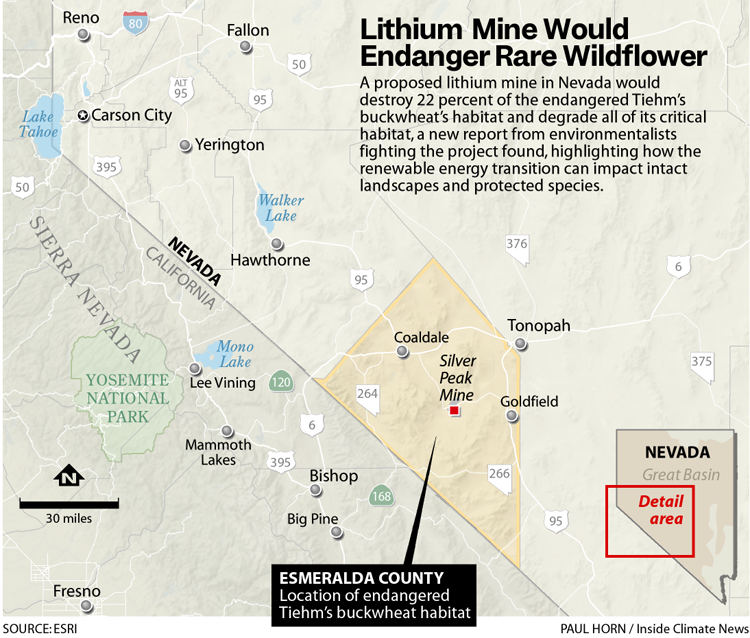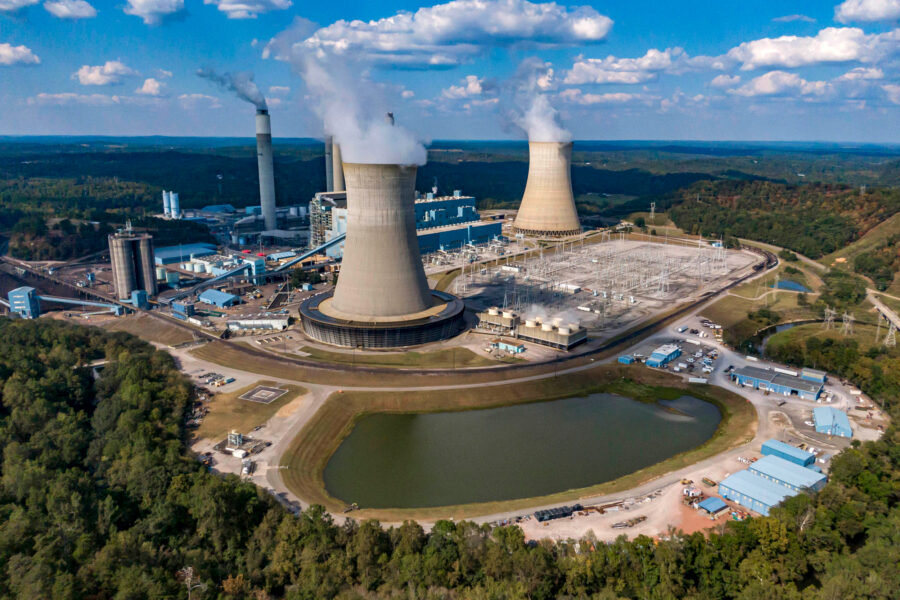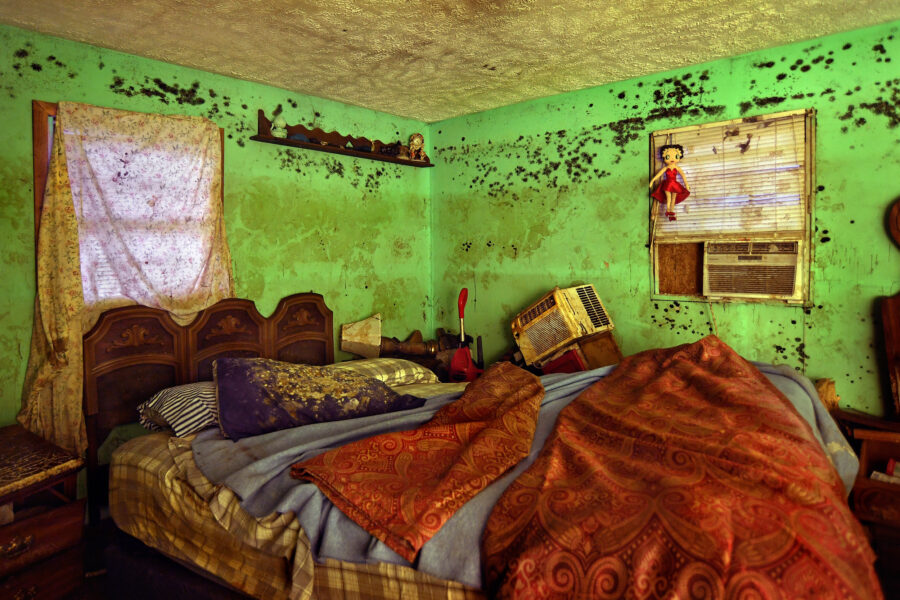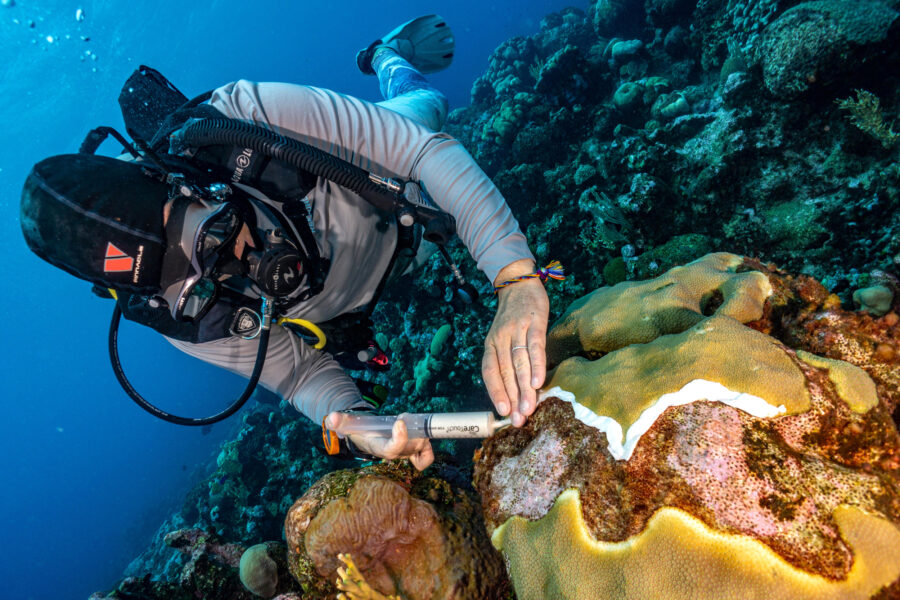A Nevada Lithium Mine Nears Approval, Despite Threatening the Only Habitat of an Endangered Wildflower
The Biden Administration signaled it was on the verge of approving a proposed lithium and boron mine in Nevada’s Silver Peak range that would quadruple the nation’s current production of lithium and potentially power 340,000 electric vehicles—though at the cost of roughly 20 percent of an endangered wildflower’s critical habitat.
Thursday, the Bureau of Land Management announced it has “advanced” the Rhyolite Ridge mine’s review after issuing its final environmental impact statement (EIS), setting the stage for a decision from the federal government on whether to approve the project. It’s the latest in a long-running dispute pitting the BLM and the mining company, Ioneer, against environmentalists and independent scientists over whether the mine can operate without further impacting Tiehm’s buckwheat, which is only found near the proposed site of the mine.
Despite concern the mine could drive the wildflower to extinction, the project has continued to move forward. The mine, each year, would extract around 2.6 million tons of lithium, the mineral critical to batteries that power EVs and store renewable energy from solar and wind farms. It will also produce 170,000 tons of boric acid, which is used in a variety of industrial chemical operations. The mine will employ 400 to 500 construction workers for four years, and roughly 300 permanent workers over the next 19, before its lifecycle ends.
The Australian mining company has secured agreements to provide lithium to automotive companies, including Toyota and Ford Motor Company. Public records obtained by the Center for Biological Diversity, the environmental group that has led the effort to protect the wildflower, show BLM staff felt the project was on “a very aggressive schedule that deviates from other project schedules on similar projects.”
Explore the latest news about what’s at stake for the climate during this election season.
Last year Ioneer received a loan of $700 million from the Department of Energy contingent on it passing its environmental review by the BLM.
“The Biden-Harris administration is committed to responsible development of critical minerals that are needed to drive America’s clean energy economy,” Laura Daniel-Davis, acting deputy secretary of the Interior, said in a statement. “The Rhyolite Ridge project represents what we can do when we work together—with industry, states, Tribes and stakeholders—to ensure the swift consideration and adaptation of projects to fulfill our energy needs while respecting cultural and ecologically sensitive areas.”
Tiehm’s buckwheat, a small wildflower with yellow pom-poms, is an endemic species unique to the Silver Peak Range, in part thanks to adaptations that allow it to thrive on soil filled with lithium and boron—the same critical minerals that attracted Ioneer to the site. It currently exists on just 10 acres of land. Since planning for the mine began, environmentalists have worked to protect Tiehm’s buckwheat, leading the U.S. Fish and Wildlife Service to list it as endangered in late 2022 following a lawsuit and a public campaign to protect the species.
The listing designates 910 acres as critical habitat for the wildflower in order to protect the species from development and other threats, provide space for the wildflower’s population to regrow and support the soils and pollinators that help it blossom.
But under Ioneer’s current plan, up to 21 percent of Tiehm’s buckwheat’s protected critical habitat would be impacted by the mine’s open pit, according to the final EIS. Company officials told Inside Climate News they are committed to only disturbing 20 percent of the wildflower’s habitat and that they would engage in remediation of the land as soon as possible after mining it, though 45 acres will not be reclaimed, adding that Ioneer maintains a greenhouse to grow the plant and a plan to mitigate its harms.
“The critical habitat is about just under 1,000 acres,” Bernard Rowe, managing director of Ioneer, told Inside Climate News in an interview Wednesday. “We’re talking about, you know, maximum 200 acres of that 1,000 that would be disturbed by our activity, everything else has been moved outside of that critical habitat.” Ioneer would reclaim any land it disturbed once it finished working on it, Rowe added.
Impacts to that 20 percent of Tiehm’s buckwheat’s habitat could, however, harm the species, the final environmental review found. In its report, the BLM notes the habitat disruption could drive ground squirrels to forage on Tiehm’s buckwheat, reduce habitat for pollinators the plant depends on for seed production, spread invasive species that could compete with the wildflower and smother the population with dust if it was “not adequately controlled.”

In its biological opinion regarding the project’s impact on the plant, the U.S. Fish and Wildlife Service, the federal agency tasked with protecting endangered species, found the mine was “not likely to jeopardize the continued existence” of Tiehm’s buckwheat despite the project’s likely impacts, but those trying to protect the plant said that finding is not based on the best available science.
“It literally is the license to kill,” said Patrick Donnelly, the Great Basin director at the Center for Biological Diversity, of the USFWS opinion.
Assessments by environmental groups found similar threats to the plant and noted that 100 percent of Tiehm’s buckwheat would be compromised by dust, pollinator disruption and more from the mine.
“I remain more concerned than ever that the BLM ignored the best available science and issued a mine plan that could propel Tiehm’s buckwheat towards extinction,” said Naomi Fraga, director of conservation at the California Botanic Garden, who has helped lead efforts to protect the species and conducted reports on how the mine would impact the wildflower. “Scientists from around the world have rallied behind this little plant and made clear that the mine’s plans are incompatible with the conservation of the species.”
Environmentalists have also expressed concern over the mine’s groundwater consumption. No new water rights could be given to the company, as water in the basin is already over-appropriated by more than 20,000 acre feet—enough water for around 40,000 homes. Under Nevada groundwater laws, Ioneer has instead had to obtain already granted groundwater rights or lease water from farmers in Fish Lake Valley.
Rowe said Ioneer had access to 200 percent more water than it will use via the purchase of groundwater rights and agreements to lease water from farmers in the area. He added the mine will be more water efficient than other lithium mines and will recycle around 50 percent of the water used. The water, however, will have to be pumped to the mine and environmentalists have expressed concern about how constant pumping will affect the aquifer, which is currently subject only to seasonal pumping for agriculture.
The EIS found the mine would ultimately result in a drawdown of the aquifer by 10 feet, largely from the dewatering process required once the mine punctures the aquifer and the water that seeps into the pit must be removed to allow extraction of the ore.
Through the environmental review process, Rowe said the company was able to engage with stakeholders to make a mining project that was able to address concerns and will be more sustainable. “What we’ve come out with at the end, is a far superior project,” he said.
But environmentalists continue to protest the mine.
“Federal agencies seem bound and determined to approve this mine, which would be a direct assault on both Tiehm’s buckwheat and the integrity of the Endangered Species Act,” said Donnelly, who has led the fight to protect the wildflower. “We’ve been fighting to save this little wildflower from extinction for more than five years, and we’re not backing down.”
About This Story
Perhaps you noticed: This story, like all the news we publish, is free to read. That’s because Inside Climate News is a 501c3 nonprofit organization. We do not charge a subscription fee, lock our news behind a paywall, or clutter our website with ads. We make our news on climate and the environment freely available to you and anyone who wants it.
That’s not all. We also share our news for free with scores of other media organizations around the country. Many of them can’t afford to do environmental journalism of their own. We’ve built bureaus from coast to coast to report local stories, collaborate with local newsrooms and co-publish articles so that this vital work is shared as widely as possible.
Two of us launched ICN in 2007. Six years later we earned a Pulitzer Prize for National Reporting, and now we run the oldest and largest dedicated climate newsroom in the nation. We tell the story in all its complexity. We hold polluters accountable. We expose environmental injustice. We debunk misinformation. We scrutinize solutions and inspire action.
Donations from readers like you fund every aspect of what we do. If you don’t already, will you support our ongoing work, our reporting on the biggest crisis facing our planet, and help us reach even more readers in more places?
Please take a moment to make a tax-deductible donation. Every one of them makes a difference.
Thank you,
David Sassoon
Founder and Publisher
Vernon Loeb
Executive Editor
Share this article
Disclaimer: The copyright of this article belongs to the original author. Reposting this article is solely for the purpose of information dissemination and does not constitute any investment advice. If there is any infringement, please contact us immediately. We will make corrections or deletions as necessary. Thank you.








